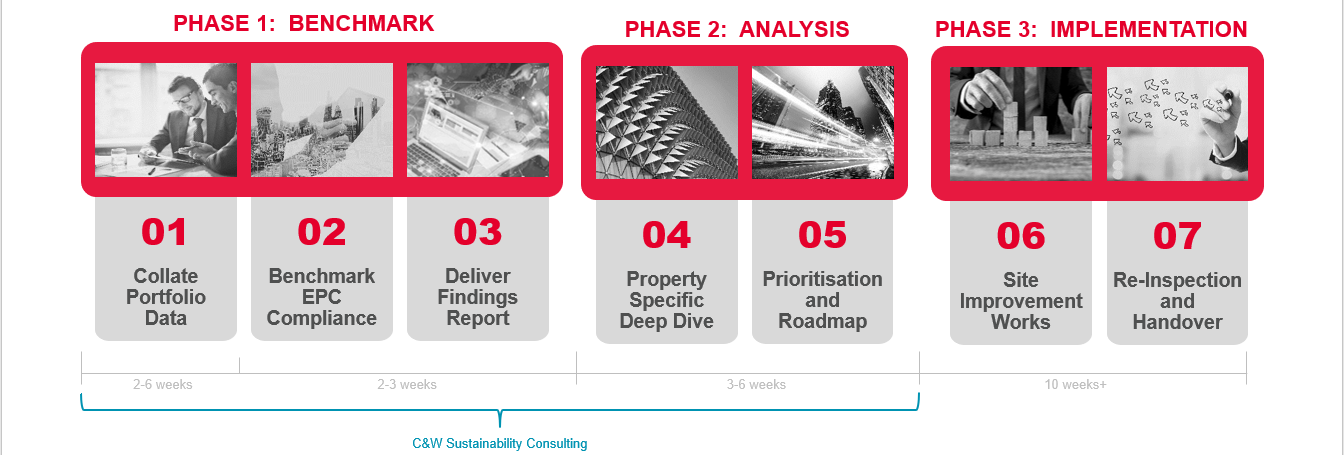Accurate Energy Performance Certificate (EPC) ratings will be critical for companies to be able to understand their risk and plan mitigation measures for the next phase of Minimum Energy Efficiency Standards (MEES) in April 2023. This phase will expand the minimum requirement of EPC to E for all leases.
However, the recent (June 2022) change in the EPC methodology means that existing EPC may not be accurate anymore. But why did this happen and what does it mean to EPC ratings? Is your E rated EPC still an E to comply with MEES requirements?
The Sustainability Team at Cushman & Wakefield can assist with navigating through these adaptations with a view to the new EPC requirements in 2023.

New Part L and SBEM – June 2022
Part L sets the standards for the energy performance and carbon emissions of new and existing buildings and provides the calculation methodology for establishing compliance. For non-domestic properties, the methodology is the Simplified Building Energy Model (SBEM), which is also used to calculate EPC ratings. Therefore, these changes will have a significant impact on all EPC ratings going forward.
Changes to Part L (Conservation of Fuel and Power) of the Building Regulations came into force on 15 June 2022, comprising more ambitious performance targets and fabric standards; the introduction of a new “primary energy” metric; updated weather files; and new carbon factors reflecting the progress made towards decarbonising the electricity grid over the past decade.
Why will this impact EPC ratings?
The new Part L includes an updated SBEM methodology (version 6.1) which takes account of changes to grid emissions factors.
In 2013, when the previous version of Part L was issued, the electricity grid was powered mostly by fossil fuels. This was reflected in the carbon factor used to calculate the emissions produced by a building based on its calculated energy consumption, which is used to generate an EPC rating.
As a result, in 2013, it was better to use gas or other fossil fuels to heat a building than electricity as the carbon emissions from gas was less than half the carbon emissions from electricity. This was reflected in all EPC issued since then using the Part L 2013 SBEM methodology.
As the UK Government is moving towards Net Zero, cleaning the electricity grid is critical. From the beginning of the year 47.5% of the electricity used in UK is produced by renewable or low carbon fuels. In 2020, it was recorded that a record high 53% of the electricity within the grid, came from renewable or low carbon sources.
As the carbon factor for electricity has improved, at the same time the carbon factor for natural gas has increased slightly. Meaning that a building heated by natural gas will likely receive a poorer rating, even though they will still get the benefit of reduced emissions for their lighting.
Figure 1.0 below shows the decrease in carbon emissions from grid electricity in the UK between 2013 and 2020, which is significant at -56.6%. Nowadays, electricity has a lower carbon impact per kWh than natural gas, and this will reduce even lower as we get closer to 2030. This is the inverse of how this performance comparison looked in 2013, therefore the new Part L SBEM methodology needs to reflect this change on how EPC will be calculated moving forward.

Figure 1.0 (source: DEFRA)
Impact of the changes
Since the new EPC methodology was introduced in June, Cushman & Wakefield Sustainability team has tested numerous properties. There is a clear and consistent pattern across all; that the updated emissions factors within SBEM methodology v6.1 have the potential to shift the EPC ratings of properties without any physical changes to the building having occurred from the time the EPC was lodged (prior to June 2022).
Generally, the inverted emissions performance of grid electricity versus natural gas, between the old and new Part L and SBEM methodology, means that properties heated by electricity can expect to achieve an improved EPC rating, whilst gas-heated properties can expect to remain the same or see a small deterioration. The extent of the shift is however far more significant for those properties which stand to benefit from the updated methodology than those that do not.
Our approach
Cushman & Wakefield have a highly integrated approach, combining data, technology and project management to help clients navigate through both the analysis and delivery of their EPC objectives. We have partnered with leading Dutch sustainability compliance company CFP to create an innovative, flexible and truly responsive solution, leveraging key data and market leading expertise to give our clients clarity, insights and solutions.

Using cutting edge technology, we help clients benchmark and understand their current risk and exposure meeting MEES legislation and the impact of the new EPC methodology, without having to visit and assess all their properties. Once this baseline is identified in our online tool, using our extensive knowledge we do a deep dive and analyse the properties with the highest risk. Our real estate experts provide strategic advice and our technical experts can carry out the necessary works to improve the EPC rating of the buildings.
If you have any questions or would like consultancy support to understand the potential impact on your portfolio, please contact:



